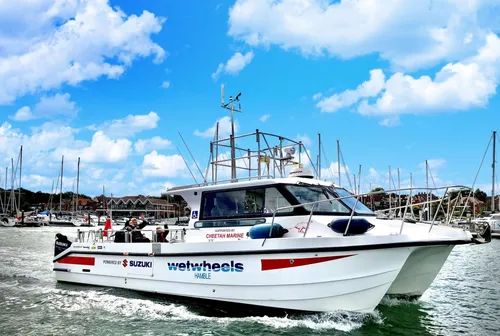Whangaparaoa, New Zealand – 1944
Commander Gibson pressed the cigarette into the chipped glass ashtray and leaned over the laboratory bench. The air inside the operations hut was thick with salt, sweat, and the metallic tang of cordite. Somewhere outside, the gulls were screaming into the wind, their cries whipped thin by the endless Pacific.
Out on the horizon, the ocean stretched flat and colourless, a cold grey sheet pressed against the ragged volcanic coast of Whangaparaoa Peninsula. The bay lay still now, but the air trembled faintly with the tension of men and machines. Outside, a detail of sailors were stringing cables again, long black veins that vanished into the surf, disappearing toward a barge floating nearly a mile out.
“Two minutes to detonation!” someone called through the doorway.
Gibson nodded without turning. His eyes were fixed on the row of instruments laid before him. Oscillographs ticked lazily; the fine stylus arms quivered with the motion of the earth and the sea. The smell of hot dust, oil, and ozone mingled with the faint aroma of tobacco. He rubbed his sleeve against the condensation fogging the instrument glass and squinted at the readings.
Nothing unusual—at least not yet.
Behind him, Professor Thomas Leech sat quietly, a notebook balanced on his knee. The old man’s face was lined and solemn, a teacher’s face—kindly once, perhaps, but now carved by war and sleepless nights. His grey hair was unkempt, his cuffs frayed. Yet his eyes, beneath the heavy brows, remained sharp as a knife.
“I still think this is folly,” Leech murmured without looking up. “You can’t bully nature into cooperation.”
Gibson smiled faintly, adjusting a dial. “With respect, Professor, that’s precisely what we’ve been doing since this war began.”
Leech gave a small grunt—neither amusement nor agreement. He scribbled something in the margin of his notes, then looked up through the dusty window toward the horizon.
Outside, the countdown began.
“Ten seconds!”
Gibson moved to the window. In the distance, the barge floated like a toy in the pewter light. A gull wheeled above it once, then vanished as if sensing the change in the air.
“Five! Four… three… two—”
A small white puff blossomed on the horizon, followed by a dull, rolling concussion. The hut shuddered. The instruments rattled on their mounts. For a long moment, nothing, just the faint echo of thunder over the water.
Then, slowly, the swell began to rise.
It wasn’t dramatic: just a broad, lazy heave in the surface, the kind of motion a fisherman would barely notice. But Gibson saw the pattern forming, the subtle harmonic of the sea disturbed. The wave travelled shoreward, broke in a low sigh against the rocks, and withdrew again like the breath of a sleeping animal.
“Reading?” Hale asked.
Leech tapped his pencil against the notebook. “Eighteen inches at best. Not even a fisherman’s wave.”
Gibson frowned. “But it’s consistent. The frequency is right. The amplitude is higher than last week’s.”
“Perhaps.” Leech turned another page. “But the sea is not a laboratory, Commander. You can’t stack the variables and expect obedience.” He looked up. “Still… I’ll admit—it’s a curious business.”
Gibson glanced at the file marked SEAL – Confidential lying on the desk. Inside were diagrams of coastal profiles, mathematical equations, tables of explosive yields, and a chain of cables from Pearl Harbour demanding progress reports. Somewhere in Washington, an admiral had decided that the ocean itself might be turned into a weapon—a wave bomb, a tsunami machine, the sort of phrase a journalist might have coined if only he knew.
The Navy had supplied the men, the explosives, and the ambition. New Zealand had supplied the coastline.
That was how things worked in this war.
By evening, the station was alive with the brittle chatter of the wireless. Morse operators tapped at their keys while the smell of boiled tea and diesel drifted through the camp. Gibson stood at the map table in the briefing room, studying the latest orders under a flickering bulb.
Another round of tests had been authorised, larger this time. The figures looked absurd: eight kilometres offshore, multiple detonations in sequence, yields equivalent to several thousand tons of TNT.
The Admiralty wanted results before the year was out.
Gibson traced his finger along the red pencil lines that marked potential targets: the coastlines of Japan, the Philippines, Formosa. To the men who drew these maps, they were simply shapes to be erased, harbours, ports, beaches. Potential leverage.
A weaponised wave would mean no planes, no invasion fleet, no costly amphibious landings. Just the quiet, unstoppable force of water swallowing a city whole.
It was madness. But war thrived on efficient madness.
That night, in his narrow quarters, Hale wrote in his logbook:
Test Forty-Six: Increased detonation yield. Slight amplification of wave patterns. Recommend further study.
He did not write what he truly thought: that the ocean felt alive—provoked, angered, and patient.
In the weeks that followed, the tests grew bolder. Explosions farther out, deeper charges, new mathematical models to predict resonance and wave height. Hale’s men worked like engineers possessed, their faces reddened by wind and salt.
They began to call it “the bomb that moves mountains.”
One morning, a cable arrived from Washington. Gibson unfolded it carefully, the paper stiff with damp. At the bottom was the signature of Admiral Halsy, the man who had first noticed the peculiar wave formations during coral-clearing operations in ’42.
If successful, SEAL device could deliver coastal destruction equal to several hundred tons of TNT without enemy interception. Proceed with utmost secrecy. Results to be conveyed directly to Naval Intelligence, Pearl.
Gibson folded the cable, his jaw tight.
Leech, who had been reading over his shoulder, said quietly, “You realise what this means, don’t you? You’re trying to weaponise the earth itself.”
Gibson exhaled smoke. “We’re not trying to break the planet, Professor. Just make the enemy reconsider their coastline.”
Leech turned sharply. “And when it’s over? When peace comes, what then? You think these ideas vanish? They sleep, and someone, somewhere, will wake them again.”
Gibson said nothing. He only listened to the slow breathing of the sea beyond the window.
The disaster at New Caledonia came in August.
The charges had been laid too close together; one of the barges drifted out of position. When the ignition line fired, the second detonation triggered prematurely.
A great concussion cracked across the bay. One barge vanished in spray. The other capsised. Two men were thrown overboard. Only one was found.
The resulting wave was far larger than predicted, a dark, rising wall that swallowed the observation launch in green-black chaos. Gibson was slammed against the cabin door. For a moment he saw nothing but churning water, bubbles, and fear.
When it passed, the deck was awash with oil and fragments of equipment.
Leech stood beside him, drenched, his notebook destroyed. “You’ve got your wave, Commander,” he said grimly. “I hope you’re proud of it.”
Gibson could not answer. The data, what little survived, showed that they had succeeded in producing a measurable, destructive surge. Not yet a true tsunami, but close.
The report sent to Washington was concise, written in the flat language of the military.
Successful amplification observed. Further refinement required. Two casualties, non-operational impact minimal.
The men’s names appeared in a footnote.
Autumn arrived, bringing longer nights and a damp chill that crept into the hut walls. Gibson found himself awake most mornings before dawn, staring out at the black water.
The project was beginning to fray. Supplies were scarce. Half the sailors had been reassigned to the Pacific fleet. The Americans had new priorities, something enormous, whispered about but never named.
When Hale finally saw the memorandum, months later, it carried a single phrase that chilled him: uranium-based ordnance.
Compared to that, Project Seal was a curiosity, an eccentric footnote.
Leech sensed it too. “They’ve moved on,” he said one afternoon, standing beside the test tanks. “There’s a new toy now. Something that burns brighter than water ever could.”
Gibson looked at him, weary. “Maybe that’s for the best.”
“Is it?” Leech closed his notebook for the last time. “You think they’ll forget what they learned here? No, Commander. Knowledge doesn’t vanish. It changes shape.”
The final test came in late November.
It was small, almost ceremonial. A single barge, a minor charge, a few weary technicians marking data that no one would ever read.
When the detonation rolled across the bay, Gibson felt more sorrow than triumph. The wave that came ashore was barely a ripple.
That evening, he typed the final report himself:
Conclusion: A single explosion is insufficient. Sequential detonations of 2,000,000 kilograms of explosives at 5 miles offshore may produce a destructive wave. Feasible but impractical under wartime conditions.
He read the words twice before adding a final line:
Recommend termination of experimental program.
The report went into a file, stamped CLASSIFIED, and stored in a steel cabinet in Auckland.
That was how a dream ended, in a paragraph.
On his last day at Whangaparaoa, Gibson walked alone along the black sand beach. The wind had risen; foam raced up the shore and hissed at his boots.
He stopped where the water met the land and looked out to sea. The horizon was empty, indifferent. Somewhere beneath that grey surface lay fragments of metal, wire, and human ambition.
Leech joined him quietly, hands in his coat pockets. They stood together for a long time without speaking.
At last, the professor said, “You know, Commander, if I’ve learned one thing about men, it’s that they rarely destroy what they build. They keep it. Just in case.”
Gibson nodded. “Maybe. But perhaps the sea will have the last word.”
The war moved on, north, toward Japan. New words entered the vocabulary of horror: Hiroshima. Nagasaki. Ground zero.
Project Seal faded into the footnotes of classified archives. Its diagrams yellowed, its calculations forgotten except by a few academics who whispered about it decades later.
Gibson left the Navy the following spring. He bought a small house overlooking the sea, where the gulls screamed as they had at Whangaparaoa. He told himself he was finished with war.
Yet, some nights, he woke suddenly, hearing it again, the deep, booming roll of water, the monstrous breath of the ocean rising in anger. He would go to the window, half expecting to see the horizon lift. But the sea always lay quiet, as though pretending to be innocent.
Leech wrote to him once, in 1947, from Wellington:
They’ve begun talking again. Coastal defense committees, tidal research, civil engineering, different words for the same old urge. I wonder sometimes whether we changed the sea, or if it changed us.
Gibson never replied. He didn’t know how.
Years later, when a visiting journalist interviewed him for an article on wartime innovation, Gibson was polite but guarded.
“Did you really try to make a tsunami?” the young man asked with a grin, pen poised.
Gibson considered his answer. “We tried to understand the sea,” he said at last. “That was all.”
The journalist laughed, scribbled a few notes, and left satisfied.
Gibson watched him go, thinking of the men who had drowned, the barge that had overturned, and the brief, brutal beauty of that single great wave.
He never told anyone that for a moment, just before it broke, it had looked magnificent. Terrible, yes. But magnificent.
In the winter of 1955, a coastal storm hit Whangaparaoa with unusual ferocity. Gale winds ripped the roofs from houses; the sea surged higher than living memory.
Gibson, now older and slower, heard the news on the radio and went out to stand on his veranda, listening to the rain hammer on the iron roof.
He imagined the cables, the barges, the tiny figures working in the grey light so many years before. He wondered if, somehow, the ocean remembered them too, if it had been holding that memory all this time, waiting.
When morning came, the storm had passed. The world was quiet again.
He returned inside, made tea, and opened the window. The sea lay calm and shining under a pale sun, as if nothing had ever disturbed it.
Somewhere, deep in a government archive, the SEAL file remained. Inside:
- Leech’s final calculations.
- Gibson’s terse field reports.
- Grainy photographs of the waves breaking against the peninsula.
- A letter from Admiral Halsy congratulating the team on their “pioneering research.”
A handwritten note in the margin of the final page read:
Potential peacetime applications to be investigated, harbour construction, wave-energy projects.
It was the sort of bureaucratic optimism that could turn a weapon into a tool with a single stroke of the pen.
No the idea did not die. It simply waited, drifting through the decades like a current beneath the surface of human ambition.
In the quiet years that followed, Gibson seldom spoke of the project. But sometimes, when the wind was from the east, he would walk down to the shore and watch the tide move in slow rhythm, as though breathing.
He would think of Leech’s words: Men rarely destroy what they build. They keep it.
He would light a cigarette, the smoke curling into the salt air, and murmur to the sea, “Not everything we make is meant to be used.”
The waves never answered, but he imagined they understood.
In the faint hiss of surf along the sand, he sometimes thought he could still hear it—the echo of that long-ago detonation rolling endlessly beneath the grey Pacific, like a memory the ocean refused to forget.







This story has not been rated yet. Login to review this story.